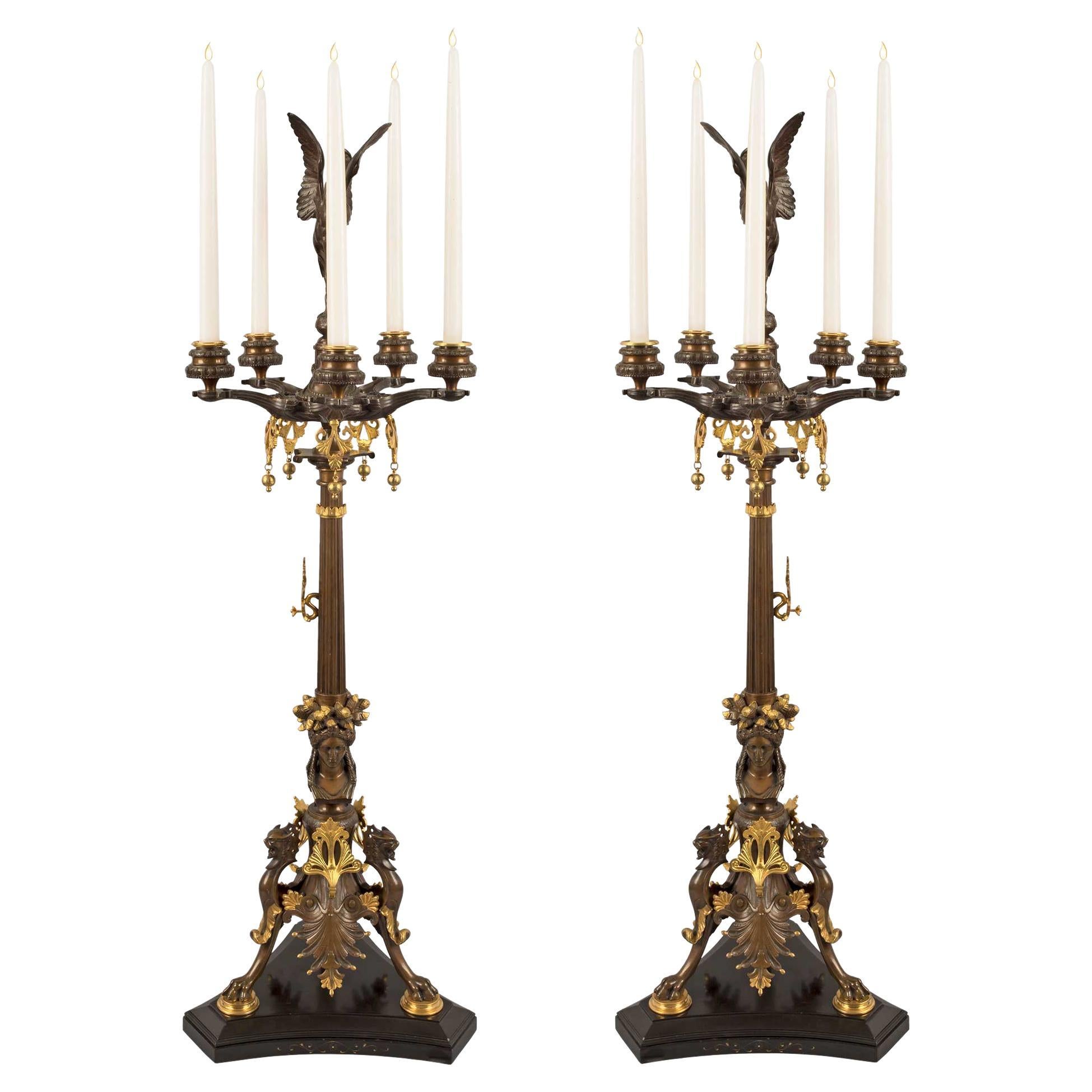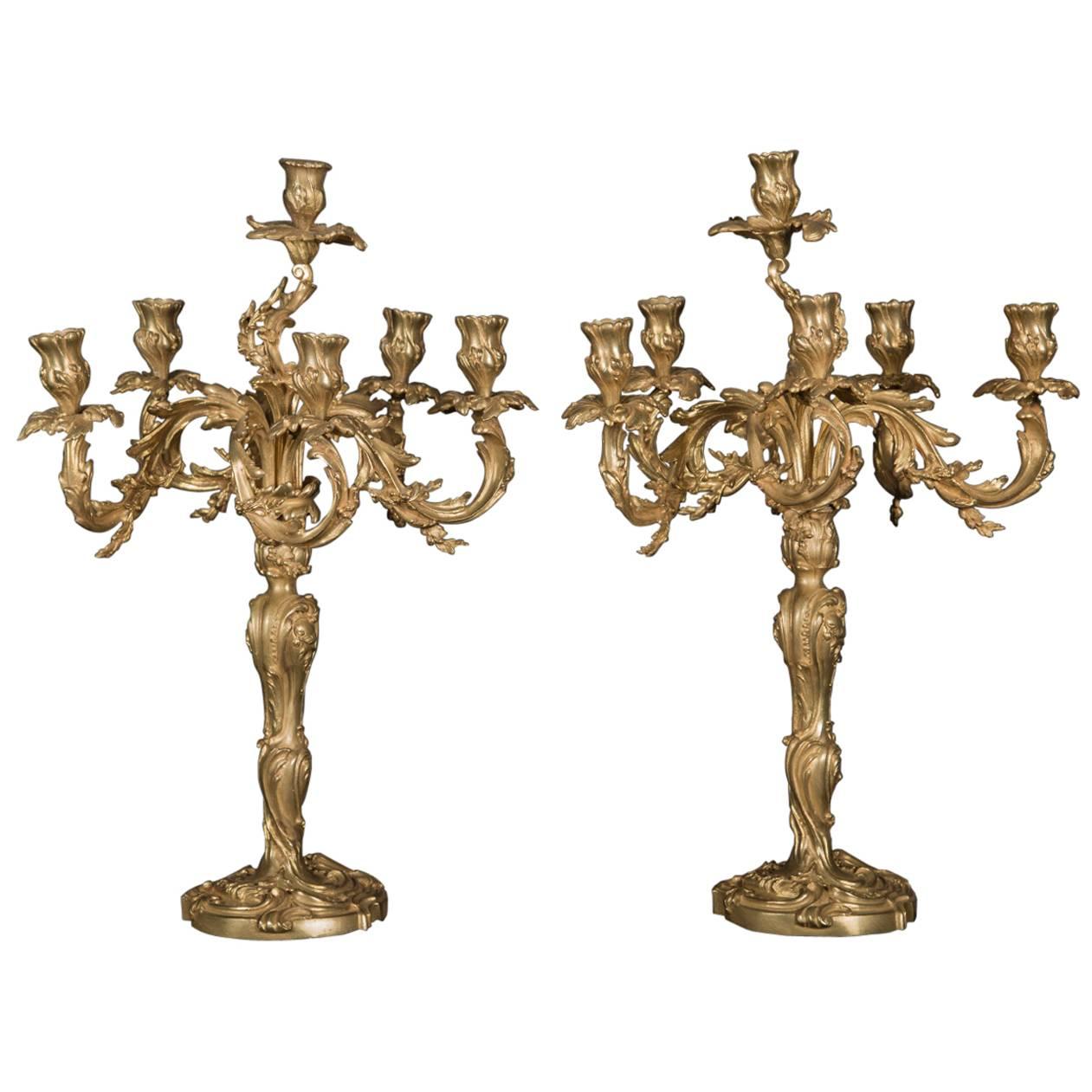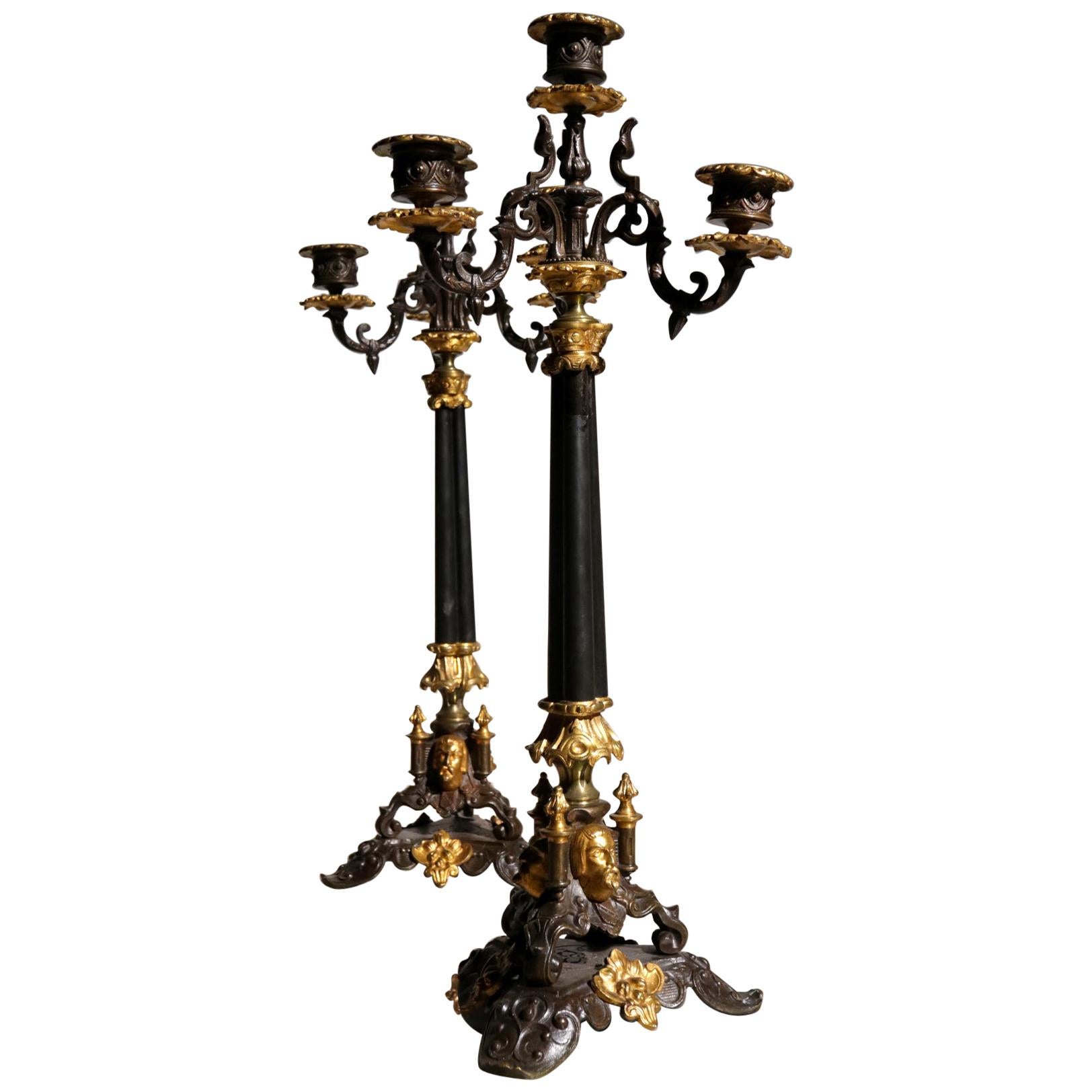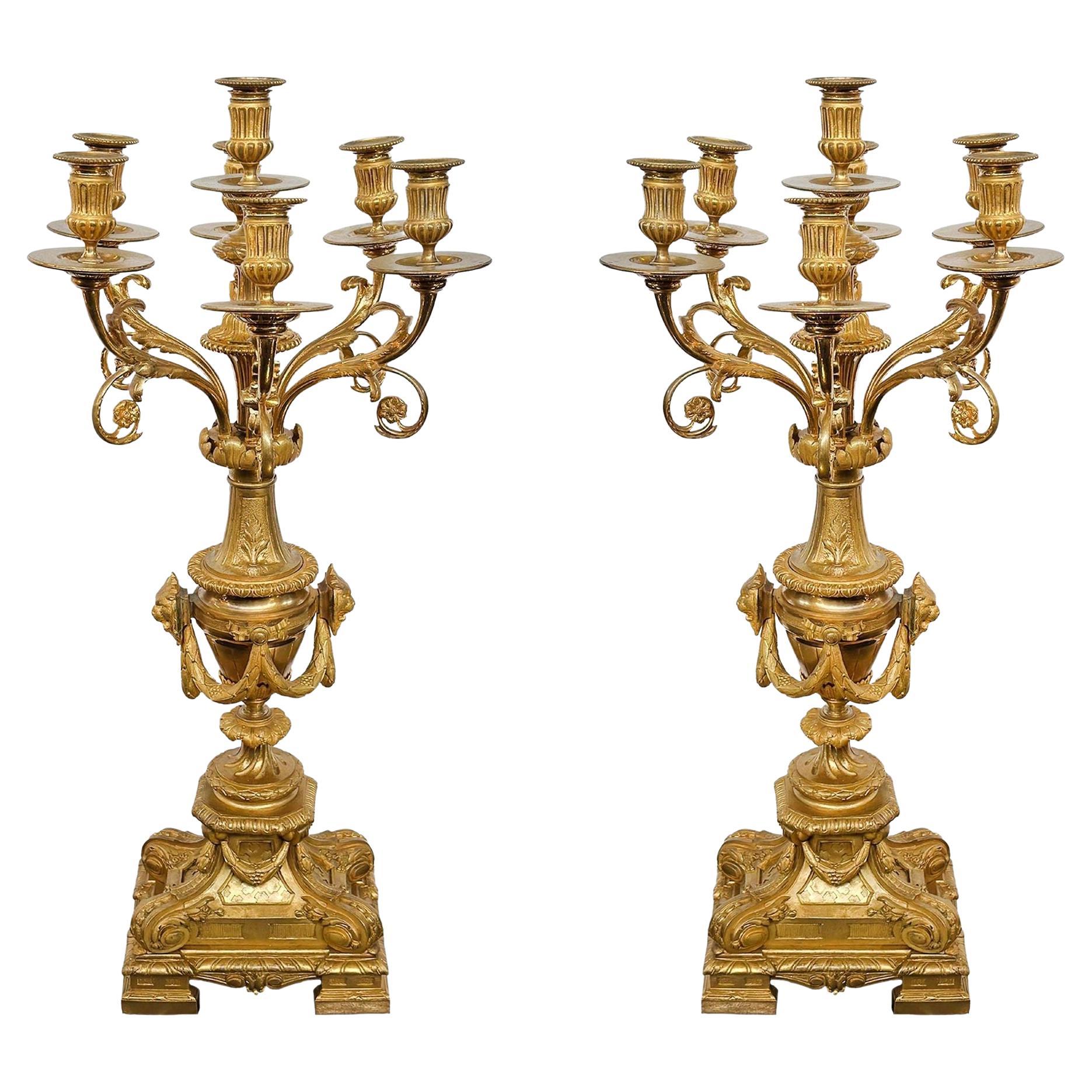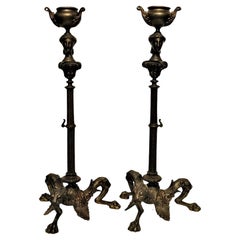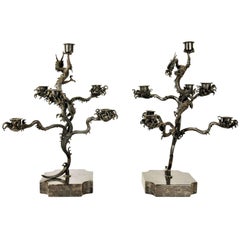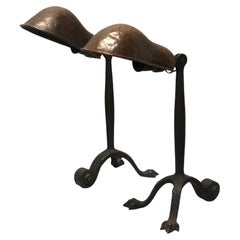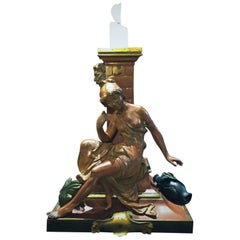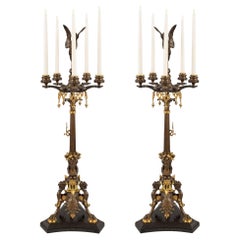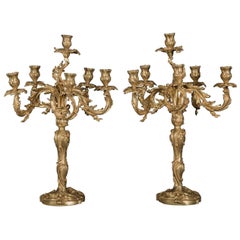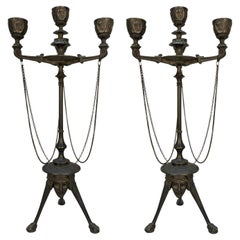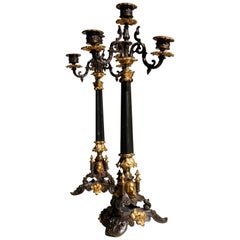Items Similar to Pair of American Rococo Revival Patinated Bronze Candelabras, Ca. 1825
Want more images or videos?
Request additional images or videos from the seller
1 of 12
Pair of American Rococo Revival Patinated Bronze Candelabras, Ca. 1825
$9,900
£7,505.56
€8,651.93
CA$13,942.56
A$15,461.27
CHF 8,123.75
MX$188,910.44
NOK 101,639.20
SEK 95,405.75
DKK 64,588.32
About the Item
Bronze, dark-brown patina, unmarked.
Measures: Height: 23”
Width: 14”
The notion of an “American Rococo” seems a contradiction in terms. The very word rococo is as French as Camembert. It connotes a style that reigned along with Louis XV in the aristocratic decadence of the 18th Century. It was garlanded, nonchalant, associated with erotic marshmallow nudes by Francois Boucher and foppish courtiers costumed as shepherds pretending they understood Jean-Jacques Rousseau when all they really wanted was romantic dalliance in the formal gardens of Versailles. In the history of painting it produced but one great artist, Antoine Watteau.
By contrast, Americans of the period are remembered as the flinty inheritors of New England Puritans, full of rectitude and having not a moment for furbelow or frippery. Such few painters as were around included hard-nosed realists like John Singleton Copley and Charles Willson Peale.
Well, as it turns out, life once again acts according to the principle of paradox. There was an American rococo. It came to us indirectly via England disguised under the name Chippendale. Now for the first time the style receives comprehensive survey in the exhibition “American Rococo, 1750-1775: Elegance in Ornament.” Jointly organized by New York’s Metropolitan Museum and the Los Angeles County Museum of Art, it opens here Sundaywith a spread of some 170 works of decorative art and a conscientious catalogue with essays by Met and LACMA curators Morrison H. Heckscher and Leslie Greene Bowman.
There are at least two ways of looking at the decorative arts. Connoisseurs appreciate their design and craftsmanship. Those of sociological bent examine objects of material culture for their revelations of history and the temper of the times. Actually neither view is complete without the other.
Stylistically the rococo reveals a longing for intimacy in its small scale and an urge to organic nature in its love of stylized vines, tendrils, tiny flowers and seashells. If it were a new manner being promoted by Madison Avenue today it would probably be called “Baroque Lite.” There is an ease about the style that makes it airy, but it has an underlying formality that bespeaks lives of gentrified cultivation rather than beer-bellied sloth. It’s fascinating to examine the flintlock firearms on view and find these weapons of death shaped and decorated with the most exquisite care by wood carvers and metal engravers.
All of this is completely consistent with the main currents of 18th-Century European thought. In France, Rousseau sang the virtues of nature and the noble savage like a present-day ecologist. In England, John Locke spoke empirically of the social contract and the notion that government rests on popular consent. Locke was so revered here that his portrait was a standard subject for carved wood finials.
The rococo was, in a way, a sentimentalized blend of these two notions. When they were purified in the Enlightenment they led to the American Revolution and Jeffersonian Neoclassicism. Same thing happened in France. Their revolution trashed the picturesque and replaced it with Napoleonic revivalist Roman grandeur.
All that suggests linkage between one’s taste in interior decor and one’s politics. Turns out it doesn’t quite wash. In the American Colonies, everyone who could afford it was crazy about rococo and bought all they could, loyalists and rebels alike. The less economically fortunate had inexpensive bookplates and trade cards printed up to give them a touch of class--as witnessed by elaborate examples on view.
Paul Revere, who would gallop to warn the British were coming, was a renowned silversmith. He is represented in the exhibition by some lovely objects from a wedding service. They are the quintessence of restrained rococo lyricism.
Benjamin Franklin spent much time in London before the Revolution, representing colonial interests and his own fasciation with the Chippendale. He supervised the building of a new family house in Philadelphia at long distance, badgering his wife with letters instructing her how to get the rococo details just right.
Philadelphia was the hot pre-revolutionary town. It became the most venturesome and inventive in its use of the rococo. The gallery devoted to Philadelphia furniture bursts with barely restrained self-confidence. Case furniture features showy hardware, chests with elaborately carved architectural tops and imaginative sculptural wood finials. Upholstered pieces are covered with dramatic fabrics in daring shades of blue, green and buoyant yellow.
Without stock markets or banks, affluent colonials used real estate and household possessions as capital investments. Thus the economic vitality of a town could be more accurately gauged by the demeanor of its dwellings and furniture than is possible today.
Boston’s glory days were on the fade so its taste became cautious and conservative. New York was full of loyalists who fled with their rococo treasures or watched them destroyed when revolutionary occupation burned large sections of the city. All the same, there is one surviving serpentine New York card table on view that purely evokes the costumes and attitudes of the period.
“American Rococo” turns around a lot of notions about the revelatory values of decorative arts exhibitions. They are not just shows to be mined for ideas about how to redecorate the study. They are studies about how to rearrange ideas of history. Even the fine arts get nuanced reinterpretation from being exhibited with emphasis on the picture frames.
- Dimensions:Height: 23 in (58.42 cm)Width: 14 in (35.56 cm)Depth: 14 in (35.56 cm)
- Style:Rococo Revival (Of the Period)
- Materials and Techniques:Bronze,Patinated
- Place of Origin:
- Period:
- Date of Manufacture:circa 1825
- Condition:Wear consistent with age and use. We make our best effort to provide a fair and descriptive condition report. Please examine photos attentively, as they are part of the description. Send us a message to request more details or discuss price.
- Seller Location:New York, NY
- Reference Number:1stDibs: LU2819323260172
About the Seller
5.0
Gold Seller
Premium sellers maintaining a 4.3+ rating and 24-hour response times
Established in 1993
1stDibs seller since 2017
85 sales on 1stDibs
Typical response time: 11 hours
- ShippingRetrieving quote...Shipping from: New York, NY
- Return Policy
Authenticity Guarantee
In the unlikely event there’s an issue with an item’s authenticity, contact us within 1 year for a full refund. DetailsMoney-Back Guarantee
If your item is not as described, is damaged in transit, or does not arrive, contact us within 7 days for a full refund. Details24-Hour Cancellation
You have a 24-hour grace period in which to reconsider your purchase, with no questions asked.Vetted Professional Sellers
Our world-class sellers must adhere to strict standards for service and quality, maintaining the integrity of our listings.Price-Match Guarantee
If you find that a seller listed the same item for a lower price elsewhere, we’ll match it.Trusted Global Delivery
Our best-in-class carrier network provides specialized shipping options worldwide, including custom delivery.More From This Seller
View AllA Pair of Bronze Neoclassical Grand Tour Candelabras, Late 19th Century
Located in New York, NY
Grand Tour
Pair of Bronze Candelabras
Late 19th Century
DIMENSIONS
Height: 10.33 inches
Width: 4.75 inches
Depth: 4.75 inches
ABOUT
We present to your attention a pair of stunning...
Category
Antique 1890s English Grand Tour Candelabras
Materials
Bronze
Pair of Japanese Patinated Bronze Candelabras, Meiji Period, ca. 1900
Located in New York, NY
This most unusual pair of original 18th century Japanese patinated bronze candelabras, uniquely designed as branches of mountain flowers entangled by a dragon, are mounted on the con...
Category
Antique Late 19th Century Japanese Japonisme Candelabras
Materials
Bronze
American Arts & Crafts Pair of Patinated Bronze Table Lamps, circa 1910
Located in New York, NY
American Arts & Crafts
A Pair of Table Lamps
Patinated Bronze
Circa 1910
DIMENSIONS
Height: 15 inches
Width: 6 inches
Depth: 12 ...
Category
Vintage 1910s American Arts and Crafts Table Lamps
Materials
Bronze
La Cruche Casee, Antique French Bronze Sculptural Desk Candleholder, circa 1875
Located in New York, NY
The inscription engraved on the gilded medallion in the center of the plinth serves as the name of this remarkable sculpture, La Cruche Casee (The Broken Jug). Made of multicolored patinated and ormolu bronze in the second half of the 19th century France, this absolutely fabulous stationary figural candle...
Category
Antique 1870s French Romantic More Candle Holders
Materials
Bronze
Antique Continental Patinated Bronze Fawn Candlestick, 19th Century
Located in New York, NY
Probably Italian, 19th Century patinated bronze candlestick in form of a dancing Fawn holding a candle-vessel in his hands, on its original wood base.
Category
Antique 1880s Italian Belle Époque Figurative Sculptures
Materials
Bronze
Pair of Mid-Century Modernist Anodized Brass Lotus Candlesticks, USA, 1950s
Located in New York, NY
A duo of anodized brass candlesticks, each featuring a round base, stem and a lotus flower that contains a regular size candle. Manufactured in the USA during the 1960s.
The cand...
Category
Mid-20th Century American Mid-Century Modern Candlesticks
Materials
Brass
You May Also Like
French 19th Century Renaissance Style Ormolu and Patinated Bronze Candelabras
By Ferdinand Barbedienne
Located in West Palm Beach, FL
A stunning true pair of French 19th century Renaissance st. black Belgian marble, ormolu and patinated bronze, five arm candelabras, attributed to F. Barbedienne. Each candelabra is ...
Category
Antique 19th Century French Renaissance Candelabras
Materials
Belgian Black Marble, Bronze, Ormolu
Pair of French 19th Century Bronze d’Oré Candlelabra
Located in New Orleans, LA
This grand pair of bronze d’oré candelabra features floriate candle cups, leaf bobeches, and arms in the classic Rococo style. The French antique pair dates back to the 19th century ...
Category
Antique Mid-19th Century French Candelabras
Materials
Bronze, Gold Plate
$12,500 / set
Pair of 19th Century Bronze Candelabra Of Greco-Roman Design
Located in Kent, Dover
A pair of English XIX Century, three branch bronze candelabra of Greco-Roman design. With masks and hung with chains.
Category
Antique 1810s English Grand Tour Candelabras
Materials
Bronze
Pair of Richly Decorated 19th Century Patinated Gilt Candelabra
Located in Boven Leeuwen, NL
A pair neo-Renaissance candlesticks from the second half of the 19th century.
Richly decorated on all sides so perfect for the dining table.
Wonderful gift
Dimensions: 47 cm high an...
Category
Antique 1860s French Neoclassical Candelabras
Materials
Bronze
Pair of French Late 19th Century Bronze D'ore Candelabras
Located in Los Angeles, CA
Pair of graceful gold-plated bronze D'ore candelabras. Made in France in the late 19th century.
These candelabras boast a delightful combination of bronze and gold plating, lending ...
Category
Antique Late 19th Century French Candelabras
Materials
Bronze
Pair of French Empire Bronze Dore Candelabras
Located in Queens, NY
Pair of French Charles X (19th Century) bronze dore 3 arm candelabras with candlestick bases in two sections. (PRICED AS Pair)
Category
Antique 19th Century French Empire Candelabras
Materials
Bronze
$11,500 / set
More Ways To Browse
Rococo Architecture
Blue Patinated Bronze
Organic Candelabra
Large Carved Candle
American Antique Picture Frames
Rococo Candelabra
Antique French Baroque Rococo Style
Louis Xv Bronze Candelabra
Erotic Bronze
Neoclassical Bronze Pair Of Candelabras
Roman Bronze Works Bronze
Rococo French Candle
Roman Candelabras
Bronze Flower Candle Holder
Watch Holder
Colonial American Dining Table
Baroque Candelabra
French Rococo Candelabras
